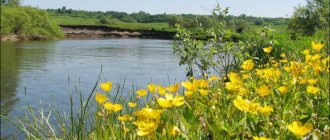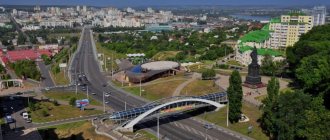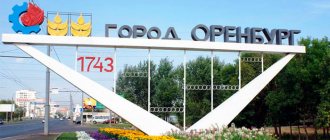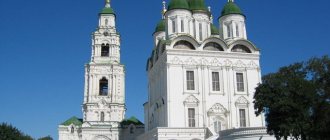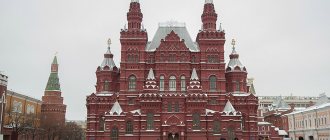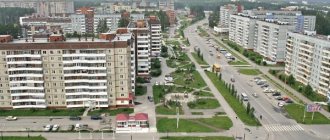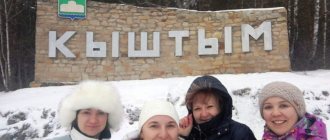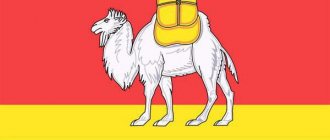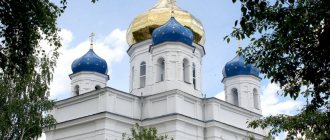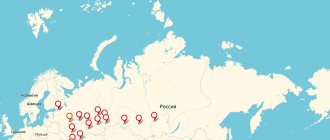Chelyabinsk is informally called the capital of the Southern Urals. It is believed that it is located on the geological border of the Urals and Siberia. It is the administrative center of the Chelyabinsk region. Population: 1.2 million people. The area of the city is about 50 thousand hectares.
It is located on the banks of the Miass River, in the forest-steppe zone. Within the city there are the Shershnevskoye Reservoir, lakes Smolino, Sineglazovo and First. It is believed that the name comes from the Bashkir word “silebe” - “depression”, “shallow hole”.
History of Chelyabinsk
Chelyabinsk was founded in 1736 as a fortress on the site of the Bashkir village of Chelyaba. Its founder is considered to be Colonel A.I. Tevkelev. The Chelyabinsk fortress was necessary to protect against attacks by the Bashkirs and to protect food convoys that moved along the road from Techenskaya Sloboda to the Orenburg fortress. During the Peasant War, in 1774, the fortress withstood the siege of the Pugachev rebels, but in February 1775, the Chelyabinsk fortress was captured.
Monument to the founders of Chelyabinsk
In 1743–81, Chelyabinsk was the center of the Iset province. In 1781 it received the status of a city and became the center of the Chelyabinsk district of the Yekaterinburg region of the Perm governorship, and a year later it was assigned to the Ufa governorship. Since 1796, in connection with the abolition of governorships, Chelyabinsk, together with the district, became part of the Orenburg province.
In 1782, Catherine II approved the coat of arms of Chelyabinsk with the image of a camel, which symbolized the passage of trade routes through the city - “a loaded camel as a sign that they are brought to this city with goods.”
Sculpture with camels on Chelyabinsk Arbat
In 1788 in Chelyabinsk, a group of doctors led by S.S. Andreevsky studied anthrax and they created the first serum against this extremely dangerous, deadly disease.
After the construction of the Samara-Zlatoust railway in 1892, connecting Chelyabinsk with Moscow, the city began to actively develop. Construction of the Trans-Siberian Railway continued from Chelyabinsk. Trade was actively developing. Chelyabinsk has become the leader in Russia in the trade of bread, as well as the second in the trade of imported tea. It was called the “Gateway to Siberia.”
Since the 1890s, Chelyabinsk was the route of numerous immigrants heading to Siberia. The largest medical and nutritional resettlement center in the country operated near the railway station. Hundreds of thousands of people passed through it. On some days, up to 25 thousand people gathered at the Chelyabinsk station.
Monument to the founders of the city on Kirovka
If in 1897 only about 20 thousand people lived in Chelyabinsk, then by 1917 the population was already approaching 70 thousand. For its rapid growth, some observers called Chelyabinsk the Trans-Ural Chicago. Growth continued during Soviet times. In 1976, the millionth resident was born here.
In May 1918, an armed mutiny of the Czechoslovak Corps occurred at the Chelyabinsk railway station, after which the fire of the Civil War flared up in the Southern Urals. In July 1919 the city returned to the Bolsheviks.
On September 3, 1919, Chelyabinsk became the center of the created Chelyabinsk province, and on November 3, 1924, the center of the Chelyabinsk district of the vast Ural region. On January 17, 1934, the Chelyabinsk region was created. It is interesting that in 1937 the issue of renaming Chelyabinsk to Kaganovichgrad was considered.
During the first five-year plans and during the Great Patriotic War, many factories appeared here. The former trading city has turned into a large industrial center. During the war, about 70 enterprises were evacuated here from the central part of the country. In just 33 days, the Chelyabinsk Tractor Plant, which merged with two evacuated enterprises, mastered the serial production of T-34 tanks. Here, the assembly of tanks was put on the assembly line for the first time, and then the experience was adopted by Uralvagonzavod in Nizhny Tagil. During the Great Patriotic War, Chelyabinsk provided the front with 16,323 tanks and self-propelled guns, 43,811 tank engines, 85 thousand sets of fuel equipment, and a large number of artillery and mortar ammunition corps. By the end of the war, every third tank and combat aircraft contained Chelyabinsk steel. Informally, Chelyabinsk began to be called Tankograd.
Monument to volunteer tankers on Glory Boulevard
By 1980, the city's enterprises produced more than half of the all-Union production of stainless steel, a fifth of pipes produced in the USSR, a third of ferroalloys, and up to 40% of road vehicles. Today it is still one of the largest industrial centers in the country.
Chelyabinsk suffers greatly from air pollution and other environmental problems. Every year, the Chelyabinsk region takes last or penultimate place in the environmental rating. Even the meme “The City That Smog” was born (smog in this case is not a verb, but a noun meaning dirty air). An even more common meme is “Harsh Chelyabinsk.”
On the morning of February 15, 2013, a huge meteorite, called Chelyabinsk, entered the Earth’s atmosphere near the city. It was the largest meteorite to hit Earth in at least the last century. Chelyabinsk and its surroundings were heavily damaged due to the blast wave. Many window panes were broken, and more than 1 thousand people were cut by fragments. The largest fragment of the meteorite fell into Lake Chebarkul. Now it can be seen in Chelyabinsk in the Historical Museum of the Southern Urals.
City information
Chelyabinsk is the administrative center of the region of the same name in the Russian Federation. Located on the slope of the Ural Mountains, near the Miass River. The economy is represented by enterprises of the metallurgical, mechanical engineering, textile, electrical, and food industries. There are service and trade companies operating.
Near the settlement there are federal highways: M5 Ural, M51 Irtysh, and a number of European routes. There are major railway lines of the Trans-Siberian Railway. There is an international airport of the same name. There are vocational educational institutions, universities and their branches. The population is about 1 million 200 thousand people.
Sights of Chelyabinsk
In the center, you can start exploring the city from the State Historical Museum of the Southern Urals (Truda St., 100, tel. 263-08-32). It was founded on July 1, 1923 as the Museum of the Local Region. In 2006, a new spacious building was built specifically for the museum on the banks of the Miass River. The permanent exhibition consists of three large halls: “Hall of Nature and Ancient History”, “Hall of History and Folk Life”, “Hall of History of the 20th Century”. There is a fairly rich archaeological collection here. The museum also hosts various temporary exhibitions. In the summer there is an exhibition on the observation deck on the roof. In the museum you can see the largest fragment of the famous Chelyabinsk meteorite. For information about other Chelyabinsk museums, see a separate review.
Nearby is the Rock Garden , and behind it, near the Megapolis Cultural Center, the Ferris wheel “360” (51a Sverdlovsky Prospekt). It is considered the highest all-season mountain in Russia (73 meters). The wheel is equipped with comfortable 6-seater panoramic cabins. The viewing range is up to 5 km in any direction.
On the other bank you can see the unusual building of the Shopping Center (Kaslinskaya St., 64). It is quite unique from an architectural point of view. Built according to a design by the Moscow Giprotorg Institute, which at that time had no analogues in the world. The roof of the building is a reinforced concrete dome measuring 102x102 m, and there are no internal columns. The structure rests on the corners. Special rollers allow the dome to shrink or expand slightly depending on the ambient temperature. The dome area is more than 1 hectare, weight is over 5000 tons. A model of the dome was exhibited at the international exhibition in New York in 1974 and in London in 1978. In 1976, the project received a first degree diploma at VDNKh.
Next to the Ferris wheel, in the Yunost sports palace, there is a Chelyabinsk bus station.
Let's go on the other side of the historical museum. A monument to S.S. is erected here. Prokofiev - an outstanding Russian and Soviet composer. He is depicted sitting on an armchair with an open music book lying on his knee. The monument was made by sculptor V.A. Avakyan.
The Trinity Bridge was built nearby . Here was the oldest crossing across the Miass in the city. The bridge is lined with granite, decorated with Kasli casting, and is illuminated in the evening.
On the other bank, near the bridge, in the park near the Rodina organ hall, in November 2022, a monument to Pyotr Stolypin , Chairman of the Council of Ministers of the Russian Empire, was unveiled. The author is sculptor Anton Plokhotsky. According to the initiators of the installation of the monument, Stolypin’s reforms gave impetus to the development of Chelyabinsk. The building itself was built in 1950 in the Stalinist Empire style for the Rodina cinema.
But let's go back across the bridge. On the other side of the bridge stands the building of the concert hall named after. S.S. Prokofiev (Truda St., 92a). It represents the thrice rebuilt former shops of the merchant Akhmetov (1880-1902), and the merchant Galeev (1905). In 1929, these two stores were rebuilt into the Proletary cinema. In 1946-48, according to the design of architect K.D. Evteev, the former cinema building was reconstructed into a musical theater. In 1948, the building housed the Chelyabinsk Operetta Theater, and on August 1, 1950, the building was transferred to the Chelyabinsk Philharmonic.
On the other side of Truda Street is Yaroslavsky Square, where the Nativity of Christ Cathedral used to stand, demolished in 1932, and now the Chelyabinsk State Academic Opera and Ballet Theater . M.I. Glinka. The theater building was supposed to be commissioned in 1941, but the war intervened in the plans and the evacuated factory moved in. The theater building was finally completed only in 1955.
In 2004, a monument to M.I. Glinka . The composer is depicted in full height. With one hand he leans on a large music book, and in the other he holds an accordion. Sculptor: V.A. Avakyan, architect E.V. Alexandrov. There is a beautiful fountain nearby.
From here begins the main central attraction of the city - the pedestrian street Kirovka . In my opinion, it is the most pleasant and interesting of the pedestrian streets in the entire Urals (and even better than Moscow’s Arbat). Kirovka was opened in 2004. It occupies a section of Kirova Street from Trud to Lenin, its length is approximately 820 m.
If you walk along Kirovka from the Miass River, you will first come across a monument to the founders of the city . At the base of the high spire with the figure of the Archangel Michael there are four bronze figures: a Cossack with a pike, a Bashkir, a peasant with a saw and officer Tevkelev - the founder of the fortress. On the sides of the stele there are information boards with excerpts from archival documents. By the way, it was at the intersection of Truda and Kirov streets that the Chelyabinsk Fortress was built in 1736.
Nearby are the sculptures “Mother, Child and Dove”, “Hands, Ball and Cap”, “TV Camera”, “A.S. Pushkin" (according to another version "Onegin"). Further down the street you will see the sculptures “Fireman”, “Carriage and Page”, “Lefty Shoeing a Flea”, “Artist”. At the intersection with Marx Street, you can pay attention to the art object “Zodiac Signs”: 12 signs are depicted on square metal tiles and built into the asphalt in a chaotic manner.
Next is a monument to internationalist soldiers. Here sits a bronze warrior with a guitar (remarkably similar to Alexander Rosenbaum), and next to it is a stone with an excerpt from the song “Black Tulip”. Nearby stands the business building (Kirova St., 159) - the city’s first skyscraper, 23 floors high, built in 2004-07. There is an observation deck here.
Walking further along Kirovka, you will come across the sculptures “Postman”, “Shoe Shine Man”, “Zero Mile”. The Main Post Office is located nearby. the Boulevard of Glory adjacent to Kirovka there is a monument to those who fell in the Great Patriotic War with the Eternal Flame and a monument to volunteer tankers.
Nearby there are the following sculptures : “Veteran”, “Carrier”, “Boy with Camels”, a monument to a penny, an art object “Bench of Love”. But that’s not all! Further on, on the Chelyabinsk Arbat there are sculptures “Fashionista Lady” with a mirror, “Saxophonist”, “Walker” (“Law”), “Policeman”. Decorative gates are installed at the entrance to Kirovka from Lenin.
Kirovka consists almost entirely of beautiful old merchant houses - architectural monuments. They have been well restored. Among such buildings is the house of merchant N.A. Samokhvalov (1898, Kirova St., 82), apartment buildings of A.P. Kholodov (1896-1906, Kirova St., 139), house of Ya.S. Plonsky (1902, Kirova St., 141), house of L.Ya. Meltser (1902-07, Kirova St., 88), Zlokazov’s store (1893-1900s, Kirova St., 92), house of merchant S.T. Sharlova (1883-84, Kirova St., 100), shop M.F. Valeeva (1911, Kirova St., 104), electrotheater "Lux" (Kirova St., 114), branch of the State Bank of the Russian Empire (1910, Kirova, 114) and others. And on the house at the address Lenin Ave., 54 / Kirova, 177, a memorial plaque to A.L. Chizhevsky. The outstanding scientist, founder of geleo-cosmobiology, thinker Alexander Leonidovich Chizhevsky (1897-1964) lived in this house until his arrest in 1942. The house in which V.K. worked has also been preserved. Blucher.
Truda Street is also rich in old houses : the Stakheev store, the Shikhov-Pokrovsky house (1850s, Truda St., 98), the arcade and house of the Yaushev brothers (Truda St., 92a and 92), the house of the doctor V.G. Zhukovsky (Truda St., 88), the Smolin-Novikov house (1820s, Truda St., 86), the house of the Stepanov brothers (Truda St., 82), the house of V.M. Kolbina (Truda St., 66). On other Chelyabinsk streets you can see the Danziger-Vysotsky mansion (1911, Pushkin St., 1), the mansion of M.P. Arkhipov (1911, Kommuny St., 68), house of G.A. Bashkirov (1908, Vasenko St., 25), building of the tea-packing factory A.G. Kuznetsov (1904, Vasenko St., 37), Lorentsov's mansion (Krasnoarmeyskaya St., 100), house of Lieutenant Zhemchuzhnikov (1894, Karl Marx St., 50), mansion of A.V. Breslina (Zwillinga, 15).
But let's return to Kirovka. Revolution Square begins . The architectural ensemble surrounding the square was formed by the end of the 1950s. As expected, there is a monument to V.I. Lenin. In the summer there is a “singing” light and music fountain on the square, and in the winter an ice town is built here.
To the side of Revolution Square, on the corner of Lenin - Vorovsky, there is the building of the Arbitration Court , which is an architectural monument. It was built in 1934. They started to build in the constructivist style, but at the last stages of construction it was rebuilt into neoclassical. Near this building on Vorovskogo Street there is a sculpture made from scrap metal “Venus” , the attitude towards which is ambiguous among the townspeople.
In general, Lenin Avenue in this part is interesting for the architecture of Stalin’s time , among which there are interesting examples of neoclassicism. Here you can pay attention to the buildings of the NKVD Town (1936, Lenin Ave., 63-67), the house of the architect T. Ervald (1937, Lenin Ave., 61, 62), the Public Library, the Bank of Russia, the house of employees of the Regional Executive Committee (1938, Ave. Lenina, 54), hotel "South Ural" (1935-41), residential buildings of the 1930s (Lenina Ave., 49, 50). The Soviet buildings of the city administration (1958, Revolution Square, 2), Chelyabenergo (1955), and the South Ural Railway Administration (1937-42, Revolution Square, 3) also overlook Revolution Square.
Revolution Square smoothly turns into Theater Square . There is a sculpture “Camel” . Its author, Rafael Saifullin, lives in Finland, and the bronze sculpture was cast in Milan. The history of Chelyabinsk is shown on the camel using symbols. Here you can see images of the fortress, Sarmatians, tanks, tractors, meteorite, etc. The sculpture is very interesting and multifaceted. In my opinion, this is the most interesting monument in Chelyabinsk.
Above is the Chelyabinsk State Academic Drama Theater named after. N.Yu. Orlova (Revolution Square, 6), built in 1973-82. In plan, the building has an oval shape, lined with marble slabs (marble was brought from Koelga), the decorative entrance group is made of Kasli cast iron. The building has two theater halls: a large one with 900 seats and a small one with 150 seats. Bears the name of director N.Yu. Orlov, who directed the theater for 30 years. The building is a cultural heritage site of regional significance.
Behind the drama theater begins a rather cozy city garden named after. A.S. Pushkin . It was created back in 1904-09, and received its name in honor of the famous poet and writer in 1937 - on the centenary of his death. Here you can see the monument to A.S. Pushkin, the sculptural composition “Tatiana Larina’s Bench”, the monument “Red Communard Steam Locomotive”, a memorial stone in honor of the 150th anniversary of V.I. Vernadsky, rotunda with griffins, fountain. The attractions are open. Sometimes city holidays and festivals are held here.
Nearby is the most unusual building in Chelyabinsk - the former elevator of the State Bank (Kirova St., 130v/1). It was built in 1914-16 under the direction of engineer K.E. Zhukov, worked until the 1990s. The abandoned building, built in the Gothic style, looks creepy. Thanks to its unusual appearance, it has the reputation of a mystical, mysterious place.
Nearby, near the intersection of Vorovsky and Krasnaya streets, there is another architectural monument - a water tower . It was built in 1911-12. Previously, this was the outskirts of the city, its highest point at that time. The height of the tower was 12.5 m. Its capacity was 15 thousand buckets (or 185 cubic meters). The lower floors of the tower are brick, and the upper floor is wooden. The tower has elements of Art Nouveau style. The Chelyabinsk water supply system began from this tower (by the way, it appeared 13 years earlier than the Yekaterinburg one).
Not far from the tower, in a park near the Ural shopping center on the street. Vorovsky, there is a sculptural composition “Sphere of Love” - the most romantic place in the city. Along the edges there are sculptures in the form of bronze trees that hold a blue glass dome. It symbolizes the firmament on which you can see the signs of the zodiac. The dimensions are impressive: height 12 m, diameter of the dome 10 m. Under the dome are images of a young man and a girl in love reaching towards each other. The stone on the right symbolizes the masculine principle, and on the left – the feminine. Chelyabinsk newlyweds come here. Author: sculptor V.F. Mitroshin.
On Lenin Avenue between Krasnaya and Sverdlovsky Prospekt streets there is Aloe Pole Square . Here you can see the “Eaglet” monument , erected in 1958 and dedicated to the victims of the Civil War. This boy, a hero of the Civil War, is depicted wearing the things of an adult: a hat with a ribbon, a hood, an overcoat to the toes, and excessively large boots. Heavy military clothing creates a contrast with the youthful body and childish face. The face looks courageous and internally tense. The bronze figure was cast in Leningrad, and the pedestal is lined with polished red Zhitomir granite. Sculptor L.N. Golovnitsky, architect E.V. Alexandrov. It has the status of a historical and cultural monument of federal significance.
There is also a memorial in honor of the pioneer heroes . This is a complex of 12 cast-iron bas-reliefs installed on pedestals along the perimeter of a small area. Each bas-relief depicts one of the twelve pioneers - heroes of the Civil and Patriotic Wars. Among them are Pavlik Morozov, Marat Kazei, Zina Portnova, Lenya Golikov, Volodya Dubinin, Sasha Chekalin and others.
The monument-mausoleum of V.I. is also worth seeing on the Scarlet Field. Lenin is one of the most unusual monuments to the leader of the world proletariat. Outwardly, it resembles a mausoleum with elements of oriental motifs. The two-story building is made of granite. Two side staircases lead to the second floor. On the second floor, in a niche between two columns, there is a bronze bust of V.I. Lenin. This monument is the first monument to Lenin in the Urals. The decision to perpetuate the memory of Lenin was made by Chelyabinsk residents just two days after the death of the leader. The first stone was laid on January 27, 1924 at 18:05 local time, synchronously with the funeral ceremony of burying the body in a mausoleum in Moscow.
The bronze bust of Lenin was made by Leningrad sculptor Vasily Kozlov from the death plaster mask of Ilyich. Cast on . The progress of the work was supervised by Vera Mukhina. The grand opening of the monument took place on July 15, 1925. The event was timed to coincide with the sixth anniversary of the liberation of Chelyabinsk from the White Guards. After the opening, the monument-mausoleum served as a public library, where the works of V.I. were presented. Lenin, and during rallies it was used as a platform.
In the center of the Scarlet Field square stands the Church of Alexander Nevsky . It was built in 1911 from red brick, decorated with brick decor in the neo-Russian style. It has a three-tiered tented bell tower. During Soviet times, the church was closed. Its space was divided into two floors; it housed a printing house, a regional art gallery, a planetarium, and technical clubs of the Palace of Pioneers and schoolchildren. Since 1987, the building has been occupied by the Chamber and Organ Music Hall. In 2013, the building was returned to the Russian Orthodox Church.
Moving further along Lenin Avenue, pay attention to the main building of the South Ural State University (Lenin Avenue, 76). Externally, the building is very reminiscent of Moscow State University in Moscow. In addition, the top façade is decorated with sculptures of Prometheus and Nike (students jokingly call them “gargoyles”). And in front of the entrance there is a sculpture to the “eternal student”.
At the end of Lenin Avenue in the center of Science Square there is a monument to Academician I.V. Kurchatov . The composition includes two pylons and a statue of Kurchatov on a pedestal located between them. The hemispheres on the pylons symbolize the split atom. The height of the pylons is 27 m. The height of the statue is 6.4 m. The total height of the monument (including the pedestal) is 11 m. According to the author’s original idea, the atomic core of the monument was equipped with a special lamp from an airplane, which worked for only a few weeks. In 2006, the lighting was restored. Artist: V. Avakyan, architects: B.V. Petrov, V.L. Glazyrin, I.V. Talalay. It has the status of a cultural heritage site of regional significance.
Nearby is the Central Park of Culture and Culture named after. Gagarin . It has attractions and a 5.8 km long children's railway. There are walking routes. The Central Park of Culture and Culture occupies only part of the natural attraction of the city - the Chelyabinsk city forest . This is an island pine forest with an area of 11.8 square meters. km. It has the status of a natural monument. It is all the more valuable because Chelyabinsk is located in the forest-steppe zone. On the territory of the Chelyabinsk Forest there are dozens of large and small quarries in which building stone was mined. Now they have formed picturesque lakes. The most beautiful is the Emerald Quarry. You can walk along the forest to the Shershnevskoye Reservoir.
Near the Chelyabinsk railway station, on the station square, there is a huge 12-meter monument “The Tale of the Urals” . It was created by sculptor Vitaly Zaikov in 1967, inspired by the tales of P.P. Bazhova. A huge granite sculpture symbolizes the Gray Urals. In 2009-11, the monument was dressed in a Santa Claus costume, which became the largest in history and was included in the Guinness Book of Records.
railway station , built in 1892, remains In 1935 it was built on, and in 1960-65 the modern station building was built. In 2011, a monument to Czech legionnaires . In the area of the station, several buildings remained from the resettlement point.
And in the Traktorozavodsky district you can see the development of the social city of ChTZ , including houses built according to the designs of Moscow architects in the constructivist style. You can also visit the Victory Garden with a memorial complex, the “Good Angel of Peace” monument and an open-air museum of military equipment. And in the Metallurgical District, “German” residential areas of unusual architecture, built by prisoners of war in the 1940s, have been preserved.
Of course, these are not all the interesting sights of the city, only the most interesting and main ones. Write your thoughts about what else is worth seeing in Chelyabinsk in the comments.
Coat of arms
The coat of arms of Chelyabinsk is presented in the form of a French shield. It depicts a loaded golden camel standing on green ground. The animal is located against a silver wall with crenellations. The artiodactyl symbolizes the important transport and trade significance of the settlement. Precious metal indicates greatness and wealth.
The emblem dates back to the historical version. It was adopted by decision of the Chelyabinsk City Duma No. 59/3 of September 12, 2000. Included in the State Heraldic Register of the Russian Federation under No. 688.
The main attractions of Chelyabinsk on the map
Chelyabinsk can be reached by passenger trains, buses from neighboring regional centers or by plane. Distance from Yekaterinburg - 210 km, from Ufa - 420 km, from Perm - 580 km.
Literature:
2GIS - Chelyabinsk Wikipedia Rundqvist N.A., Zadorina O.V. Ural. Illustrated encyclopedia of local history Chelyabinsk region. Guidebook "Burdock". – Ekaterinburg: Publishing House Fest Hand, 2016. Encyclopedia of the Chelyabinsk region
Pavel Raspopov
UraloVed.ru
Location, flora and fauna
Chelyabinsk is located on the Ural-Siberian border in the southern part of the mountain range, on the banks of the Miaas River. The temperate climate and widespread forest-steppe zone have created a variety of fauna and flora. Despite the moderately cold winters, broad-leaved forests and coniferous forests find their home here. The fauna of Chelyabinsk is also rich and diverse. There are representatives of valuable fur breeds.
Kovyl in the village of Kasargi, Chelyabinsk region
In the first half of the 18th century
As already mentioned, in 1742 Chelyabinsk (the history of the city contains many amazing facts) was visited by I. G. Gmelin. He compiled the first description of the fortress. According to this document, it was located on the southern bank of the Miyass River, and in terms of fortification it was similar to Miyasskaya, however, it was larger in size. At the same time, it had only wooden walls made of lying logs, each of which was approximately 60 fathoms (160-170 m) long.
In the spring of 1748, construction of the first stone church began in Chelyabinsk, which became the main cathedral of the Iset province. Soon the city began to actively expand, and various public institutions appeared there.
Modern period
The first half of the “dashing” 90s became a difficult period for Chelyabinsk, as it was marked by bankruptcy of enterprises, non-payment of wages and underfunding of social programs. Fortunately, this situation did not last relatively long, and by the end of this decade, industry resumed work in the city, and many plants and factories entered the world market. Revival began to be observed in other areas as well. In particular, a zoo was opened in 1996. In 2004, the history of the streets of Chelyabinsk was replenished with a new page, as the famous Kirovka became pedestrianized and turned into a favorite walking place for tourists and citizens. Two years later, the State Historical Museum of the Southern Urals moved to a new building; a new building was opened, and in 2009, the Traktor ice arena was opened, which accommodates 7,500 spectators.
Among the well-known events that occurred in Chelyabinsk in the last decade, one can note the fall of a meteorite, when 7,320 buildings were damaged by the blast wave.
After the war
After the victory, Chelyabinsk became a supplier of machinery, equipment and labor for the restoration of Donbass, Stalingrad, DneproGES and other destroyed settlements and important industrial and energy facilities of our country.
In 1947, a city development plan was approved. As a result of its implementation, new neighborhoods and industrial enterprises appeared.
By 1960, the number of higher educational institutions in the city increased sharply, and in 1976 ChelSU opened there, which became the first classical university of the Southern Urals.
Particularly rapid industrial growth in Chelyabinsk was recorded in the early 80s, when its enterprises took leading positions in the production of stainless steel, pipes, ferroalloys and road machines.
The city also developed culturally. In particular, in the 80s, a new drama theater building with 1,200 seats, a chamber and organ music hall, a geological museum, as well as monuments to “On a New Path” and I. Kurchatov were opened there.
